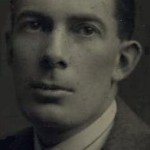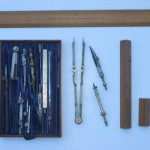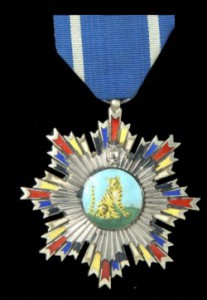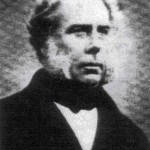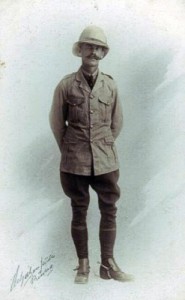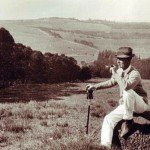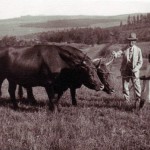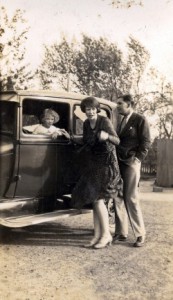
Adam’s grandparents, Guy and Catherine Newmarch, with his mother Anne, in Tientsin in the early 1930s
As an author I have drawn heavily on what I knew about my family history in China. Members of my family have lived and worked in China for four generations, and when conjuring characters for my historical romances I plundered memories of what my maternal grandmother told me over high tea when I was a little child.
For example, I made Dr Airton, the fictional doctor in my first novel, The Palace of Heavenly Pleasure, a medical missionary in Manchuria, just as my own great grandfather had been. I gave him a fixation with cowboy stories, because that had been a love of Dr David Dixon Muir on whom he was based.
Similarly, in many of the scenes in my second novel, The Emperor’s Bones, set in the China of the warlord period of the Nineteen Twenties, I wrote about my grandmother’s experiences, as she had related them to me when telling me about her life in Tientsin between the two World Wars. Like my grandmother the fictional heroine is a red head and rather wild. She marries a young man who works for the China Railways, for that had been the profession of my own grandfather.
That’s really as far as any similarity between my real family and my fiction went. I’m a novelist not a family historian. My China background merely gave me ideas on which to create authentic characters with whom I could play with as I liked. My poor grandmother would probably be rolling in her grave if she knew abut the terrible experiences I inflicted on her fictional namesake.
Of course I never admitted this. When promoting my books in speeches and articles, I gave full play to my family heritage. I suppose it was vaguely interesting in itself – I even had a few photos to make a compelling slide show – but more importantly I thought it gave me credibility. How can a fellow write authoritatively about China in the Twentieth Century if his family had never left England! On the other hand, a fellow with a China background can sell books!
What I certainly did not tell my audiences was how pitifully little I actually knew about my family. The few facts I did have I strained to the utmost in my half hour presentations.
That was the position until the beginning of this year, and it would have remained so if I had not received an email from a complete stranger, a South African called Philip Coetzee, who, while investigating the provenance of some Chinese medals in his collection, had stumbled on my website.
The result was I found my long lost grandfather. Or rather, what had happened to him.
Let me tell you everything I knew about my grandfather before Philip Coetzee’s email arrived.
- He was called Guy Lumley Biddulph Newmarch, son of Leonard and Sadie Newmarch.
- His family originated in Yorkshire. They were reputedly timber merchants in Beverley. Guy’s father, Leonard, had come to China in the late eighteen nineties to work on a railroad being built from Peking to Mukden and had stayed on afterwards. In 1919 he received the Order of the Striped Tiger from the Chinese Government.
- In due course Guy too became an engineer for the China Railways, building bridges all over North China. He had his own railway carriage which he fixed to an engine to go dawn duck shooting. He was also something of a dandy, who wore a handkerchief in his sleeve and, so a certain Colonel Cantlie once told me, built the first stereo system in China.
- He married my grandmother, Catherine Muir, in 1924. They had a daughter, my mother Anne, in 1927.
- In 1940 Guy stayed on in Tientsin after my mother and grandmother were evacuated, so that he could pack up a collection of snuffboxes and deposit them in the Hongkong and Shanghai Bank. He dawdled down to Hong Kong, where he was interned by the Japanese. In the camp he taught Latin and Greek. When he returned to Britain after the War all he could think about was food and attempted to plant a paddy field in Holland Park. My grandmother promptly divorced him and he disappeared off to South Africa.
- He sent a telegram to congratulate my mother on my birth in 1953, and after that we never heard from him again. All attempts by my parents to find him failed. Their enquiries got muddled up with somebody else’s and one day they received a notice that Guy Lumley Biddulph Newmarch had received permission to fly a single seater aircraft over Singapore. We never found out who the poor fellow was who had actually applied for that privilege. It was certainly not my grandfather.
That’s the full extent of the little I knew about him. Some of the details were diverting, but they hardly amounted to anything that approaches a biography. His story lacked a proper beginning, and certainly an end.
Out of the blue, Philip Coetzee, from Cradock, South Africa, came to fill in some of the gaps.
He told me that he remembered from his boyhood an old man whom his father had befriended. This was a retired draughtsman, who had used his engineering skills at the Cradock Municipality to do technical drawings and who now lived a life of poverty with his dog in what had once been a grand house filled with Chinese antiques, which he was selling one by one to get by – and his name was Guy Newmarch. Out of kindness, the Coetzees had looked after him until his death, of gangrene, in 1964. As a gesture of thanks for the friendship they had bestowed on him, Guy left his remaining furniture and a collection of medals to the Coetzee family. It was these medals that Philip Coetzee was now cataloguing.
Naturally I was intrigued and Philip and I began a long correspondence, during the course of which Philip was able to send me much valuable material, including several photographs of beautiful Chinese desks and wardrobes, pictures of all the medals and two particularly poignant photos – a box of draughtsman’s tools and a copy of the complete works of Sir Walter Scott, which were the only personal possessions my grandfather owned when he died.
There were still, however, more questions to be answered than mysteries revealed. The most intriguing news that Philip told me was that in the same graveyard in Cradock where my grandfather is buried there are two other graves, belonging to a couple, Leonard and Sarah Newmarsh, who had died within months of each other in 1953, the year I was born.
Newmarsh was certainly a misspelling of Newmarch, and Leonard was the name of Guy’s father, so that was clear enough. Sarah was Sadie. (This was all confirmed when Philip later sent me a copy of their wills). The reason why Guy had gone to South Africa, in his shaken state after his liberation from Stanley Internment Camp and his subsequent divorce, was to be with his parents. The big house and the Chinese furniture belonged originally to them (Guy could not have brought such clutter. He left Hong Kong destitute. His snuffbox collection is still presumably in the vaults of some Chinese bank in North China).
Also the medals, including the Order of the Striped Tiger that I had already heard about from a cutting in a gazette that somebody once sent me, belonged to Leonard not Guy – but what was not answered was what the Newmarches were doing in South Africa in the first place? What was the South African connection and why had they retired there instead of going back to Beverley?
Philip and I went back and forth on the ether but neither of us could really come up with an answer. No member of my family who might have known the facts was alive. There, it seemed, the matter would have to rest.
I should have had more faith in the magnetic powers of the Internet.
Some months later, again out of the blue, I received another email from another complete stranger, Wendy Fenton in Perth, Australia, who had not only seen my website but had also unearthed an email I had sent to a genealogical website seven years before asking for any information from any of the large Newmarch clan scattered around the world about my grandfather.
Wendy had no news about Guy but what she could provide, through the Smales family heritage that she was investigating, was information that connected the Newmarches to a dynasty of timber merchants and ship owners round Whitby and Hull in Yorkshire in the Nineteenth Century.
I had never heard of the Smales or that I was connected to them, but there followed, in later emails from her as well as two Smales descendants she was in touch with, Belinda Pascal and Jane Wynne (who had also independently come across my website), a story that could have come out of Middlemarch and involved my great great grandparents.
It centred on a Whitby patriarch, Gideon Smales, who in the 1860s, had been the grandest of the great timber merchants of Whitby and owned fleets that sailed to every fjord in Scandinavia. A growling whiskered man, he ruled his family, as he did his business, with a rod of iron. He had several children, including two daughters, Julia and Hannah, and a son called Charles.
One day a yacht sailed into Whitby harbour and standing on the prow was an elegant young man, John Newmarch, son of the vicar of Hessle. He and Julia met and were smitten. He proposed then and there and was accepted – but the patriarch would have none of it. He ordered his son Charles to drum John Newmarch out of town. The two young men had a drink instead and found they got on rather well. The upshot was that Charles arranged an elopement. The yacht left next day as Old Man Gideon had desired, but on board with John Newmarch was Julia.
In due course Julia gave birth to Leonard who in turn fathered Guy who sired my mother. It is rather splendid to know that I am the progeny of a great Victorian scandal!
And nor did the scandal end there, for, as Jane Wynne told me, Julia’s younger sister, Hannah, later fell in love with John’s brother, Douglas, and they also married (although they had to wait three months after O’wd Gideon Smales had died before they could do so!)
And even that was not the end of it – for consequences were to be felt into the next generation, affecting the lives of John and Julia’s children and also those of Charles Smales, the brother who had originally arranged the elopement.
For, as Belinda Pascal, who is a direct descendant of Charles Smales, told me, John Newmarch and Julia Smales’ son, Harry, fell in love with Charles’s daughter, Gertrude.
The old patriarch, Gideon, in his time, had failed to prevent two sisters marrying two brothers. Charles, as we have found, was of a more sympathetic nature, but now it was his turn put his foot down, not because he inherently objected to the match. He loved his daughter and was fond of his nephew – but he was worried that a marriage of first cousins might lead to children being born with genetic disabilities. No marriage would take place, he told his daughter, until she was past child bearing age.
It seems that Harry did the decent Victorian thing and left the country to make his way as a farmer in the colonies, and so he came to Greytown, thus providing at last (we think!) the South African link. (His story ended happily by the way because Gertrude, in 1926, when she had reached her late forties and her father had finally decided that it was safe for the match to go ahead, called Harry back from his self-imposed exile. It had never actually been too draconian – over the years he frequently went back to visit his fiancée, staying with her brother, Lawrence Smales, at his home, Esk Hall, just outside Whitby , but now they could be married, and were so, in St Mary’s Church, Whitby, in the presence of Gertrude’s parents.)
Meanwhile, Philip had sent me another snippet of information, having discovered where the Biddulph fitted into Guy’s name, for his mother, Sadie, was a Biddulph and here we find another South African link, because Philip’s researches had unearthed that the Biddulphs were some of the earliest colonists of South Africa, part of an emigration that had taken place in the 1820s, and by the time the Newmarches came into the picture they were a well settled South African dynasty.
It is of course conceivable that Leonard met Sadie in China – or anywhere else in a ship voyaging age – but it is a logical speculation that he met her in South Africa on his way to his railway posting in China in 1895, when it is only likely that he took the Round the Cape passage so he could drop into Greytown and visit his brother, Henry, who was then still presumably nursing his broken heart and pining for Gertrude. Did Henry introduce him to the Biddulphs? It seems plausible.
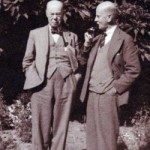
Adam's great grandfather Leonard’s brothers, Henry Newmarch and Herbert Newmarch in Greytown, South Africa, in the 1920s - Photograph courtesy of Belinda Pascal
The clincher came when Jane Wynne came up with a ship’s manifest which showed Leonard and Sadie Newmarch voyaging to South Africa on Leonard’s retirement from the China Railways in 1927, presumably with all the Chinese furniture in the hold. What was more natural? Sadie was returning home.
Unexpectedly and, as I said, out of the blue, I suddenly had a beginning to Guy’s story, just as Philip Coetzee had provided the end.
But there was even more to come, and again unexpectedly.
In November I happened to be in Hong Kong, giving one of my family talks to the Royal Asiatic Society. At the end of the talk another stranger came up to me. His name was Peter Crush, and he was an antiquarian, as many of the illustrious members of the Royal Asiatic Society are, and he was investigating the life of the Commissioner of the China Railways in the 1920s, Claude Kinder. In his researches he had come across letters from Leonard Newmarch, my great grandfather. Peter also had stumbled on my website and that had brought him to my talk.
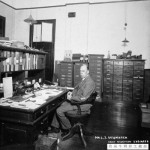
Leonard Newmarch in his office at the China Railways, Tientsin - Reproduced from the P.A. Crush Chinese Railway Collection and with the kind permission of the grandchildren of Claude William Kinder C.M.G.
What he gave me afterwards was gold dust – a photograph of my great grandfather – I had never seen an image of him before – and even better, words in Leonard’s own hand, scanned and emailed, from letters in Claude Kinder’s archives. They covered the Boxer Rebellion of 1900 and continued all the way into the mid 1920s when he was describing North China under the depredations of the Manchurian warlord, Chang Tso-lin (a figure who featured prominently in my otherwise fictional Emperor’s Bones). A real voice was speaking to me from the past. Leonard even mentioned a hitherto unknown great uncle of mine, whom Jane had been searching for, Jack Newmarch, Guy’s brother, whom the family called Punch and who had taken a job with the China Maritime Customs in Neuchang, now a dried up port in Southern Liaoning Province.
It was extraordinary. I had done nothing myself, but because of an internet website I had published, strangers, amongst whom were distant relatives (cousins through the most convoluted channels of history) had contacted me, and solved questions that had been puzzling me all my life.
Christmas is a time of magic, when the hidden forces of the universe coalesce in the imagination to create wonders, and it seems only fitting to use this season to thank the miraculous power of the web and those who are drawn to it, for the gift that they gave me this year, providing me with a family history and a heritage that I never knew existed.
There are still all sorts of questions to be answered. What happened to Jack, for example? But perhaps 2009 will provide the answers.
In the meanwhile, a blessing to the Internet and the more fundamental undercurrents of human relationships that it releases.
Whatever else, because of its magical drawing power, I know that the next time I talk about my family history in China, I will be able to do so with more authority.
And, more importantly, poor lost Guy has been brought back finally into the family fold.
